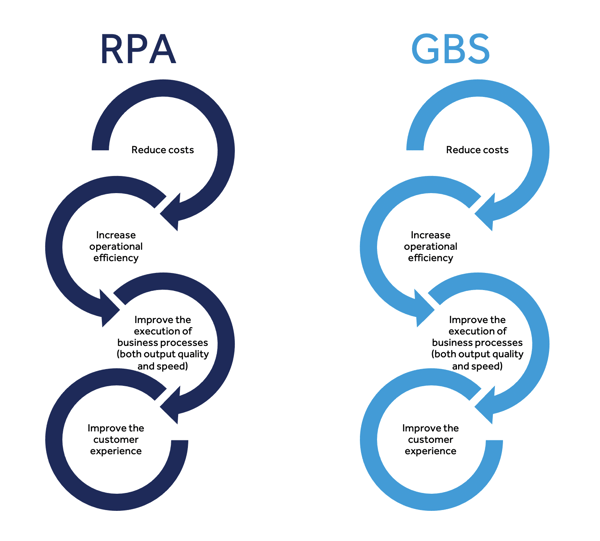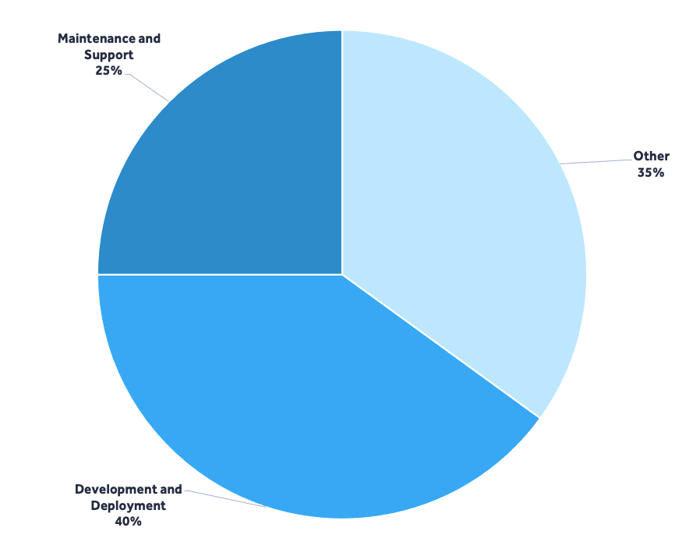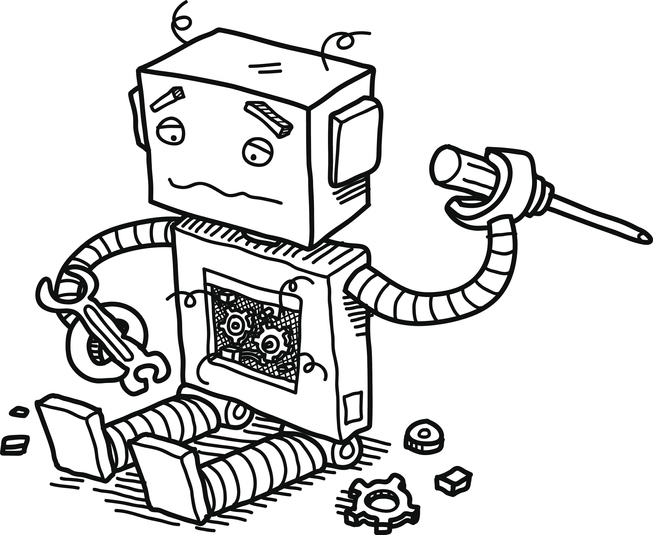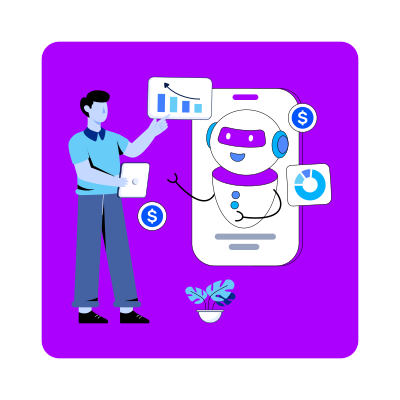How Global Business Services (GBS) Can Overcome RPA Challenges
Global Business Services (GBS) was created to morph Shared Services into something that could aid the digital transformation of enterprises with a global reach. In fact, part of the reason they shed the Shared Services moniker is because leveraging emerging technologies is in GBS’s DNA.
With that in mind, it’s only fitting that implementing and managing RPA (robotic process automation) in many organizations falls under the GBS umbrella. Side by side, RPA’s benefits, and Global Business Services’ objectives line up with almost perfect symmetry:

Even though GBS divisions have been born to drive and navigate digital transformation, it doesn’t mean they’ve been immune to the challenges RPA poses across industries. Like all other stakeholders holding the reigns of their organizations’ RPA efforts, GBS teams are also struggling to capture the full value of automation and contain RPA’s total cost of ownership.
Global Business Services and the Challenges of RPA’s Total Cost of Ownership
Regardless of whether Global Business Services teams have outsourced part of their RPA operations to BPOs (Business Process Outsourcing) or established RPA CoE’s (Center of Excellence), RPA’s total cost of ownership is outstripping their returns.
While GBS divisions may be realizing impactful benefits from the processes they have automated, their returns from automation are much less flattering when they factor in its total cost of ownership.
The two biggest cost components eating away at their ROI are RPA development and deployment and RPA maintenance and support. When combined, those two components make up 60% of RPA’s total cost of ownership and, if not contained with sound design and delivery strategy, can significantly inflate any RPA program's overhead.

Read more about Business Process Outsourcing here
Why Global Business Services Struggle with the Cost of RPA Development and Deployment
Alone, RPA development and deployment is the most expensive component of RPA’s total cost of ownership, accounting for roughly 40-50% of the outlay. Because of the weight it carries, development and deployment can inflate total costs to the point of endangering the returns automation can deliver.
That means getting it right isn’t a luxury—it’s a necessity.
Global Business Services struggle with RPA development and deployment because the most common way bots are designed and communicated for development today occurs on paper.
Slow, error-prone, and labor-intensive documents like PDDs (Process Design Documents) and SDDs (Solution Design Documents) slow automation pipelines and inflate costs because of two significant reasons:
-
Organizations have moved on from designing and delivering software by defining requirements in massive documents. Why then has RPA, a new, transformative technology, regressed to a method that has already been deemed ineffective because of the rework it causes from errors downstream?
-
Missed requirements are a constant with paper-based documentation for automation. Whether it’s missed in the document because it’s hidden or a result of document fatigue by the architect of the automation, PDDs and SDDs lead to fragile bots that break, increasing RPA downtime and the cost of development and deployment in parallel.
A better, digital form of RPA design and delivery needs to be adopted that prioritizes collaboration, alignment, visibility, and the precise guidance developers need to build higher-quality bots.
Why Global Business Services Struggle with RPA Maintenance and Support
According to standard estimations, RPA maintenance and support accounts for 25% of RPA’s total cost of ownership, but it’s a component creating the most tension in RPA programs.
The tangible benefits Global Business Services see with RPA are being counteracted with constant bot errors and outages as a result of:
-
Poor or non-existent dependency mapping – RPA is built on different technologies, which means it has a myriad of dependencies.
When there’s a change to those technologies (like the ERPs (Enterprise Resource Planner) a bot interacts with), the bot fails and requires a full-time employee to investigate the code, identify the error's root cause, fix it, test it, and re-deploy.
That’s time where the bot isn’t doing what it’s supposed to, and time an employee is pulled away from building more automations to fix those that are misfiring—which translates to value and money lost.
-
Reactive change management – Global Business Services is also struggling with RPA maintenance and support because they only react to change when it’s too late.
When a change to a legacy system, business rule, or regulation impacts a bot, corrective action is only triggered when that bot has failed, leading to unsustainable break-fix cycles that prevent RPA programs from delivering on their objectives.
To overcome these challenges and maximize their RPA programs' business value, GBS teams need purpose-built technology to better design, plan, and govern their RPA efforts.
How Blueprint Helps Global Business Services Dramatically Lower RPA’s Total Cost of Ownership
Blueprint is the only solution available on the market that’s purpose-built to maximize the value of automation and keep total costs low by helping organizations build higher-quality bots.
Blueprint’s Business Transformation Platform is a powerful cloud-based digital process and management solution that enables GBS stakeholders to better design, plan, and manage high-value automations with precision and ease by building Digital Blueprints.
Digital Blueprints replace flawed paper-based documents driving up costs. They contain everything needed for sustainable, scalable RPA delivery, including:
- Detailed process flows that can be decomposed into increasingly granular levels of detail
- Dependencies related to systems or compliance regulations
- Functional and non-functional requirements
- Automatically generated user stories, and both functional and acceptance tests
Blueprint has direct integrations with the major RPA tools, allowing Digital Blueprints to be automatically synced with the RPA vendor you use, making all critical information instantly visible and accessible to RPA developers to accelerate development with the precise guidance that leads to bots that experience 50% less errors.
Blueprint also delivers AI-assisted modeling and seamless dependency mapping that helps Global Business Services better govern their RPA programs and manage change proactively.
Because all enterprise context is also stored in Blueprint’s centralized repository, the impact of change can be instantly visualized, with the ability to coordinate proactive actions that need to be taken to mitigate bot errors and outages right from Blueprint.
Want to learn more? Read the datasheet and discover how Blueprint’s Business Transformation Platform can help Global Business Services maximize the business value of their automations while lowering the total cost of ownership.
Share this
Recent Stories

How an RPA CoE Eliminates Islands of Automation

RPA Lifecycle Management



